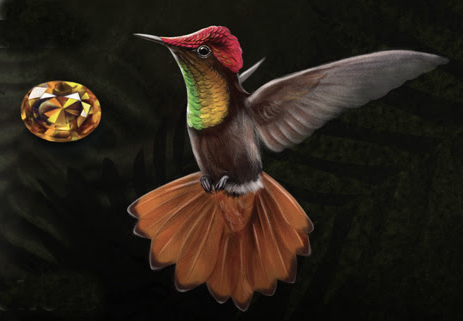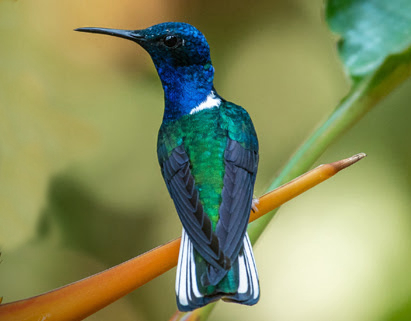
Featuring 2 gem names, the Ruby Topaz Hummingbird is illustrated by Jillian Ditmar.

You can learn more about hummingbirds, like this White-necked Jacobin that was photographed by Rio Dante, at Birds of the World.
|
With their flashy colors, hovering acrobatics, and nectar-feeding behaviors, hummingbirds are attractive and it’s especially enjoyable to share our yards with them. Hummingbirds are often described as flying jewels, but did you know that more than 50 of the 363 species of hummingbirds in the Americas are named after gemstones? Yes, the words emerald, ruby, topaz, sapphire, turquoise, garnet, amethyst, and more are used to name both gems and species of hummingbirds.
Our own Ruby-throated Hummingbird is a prime example, but there are other exotically named hummingbirds like the Glimmering-throated Emerald, the Blue-chinned Sapphire, and the Turquoise-crowned Hummingbird. The specialized feathers of hummingbirds help them achieve their gleaming, glimmering colors. You can learn how their iridescent colors are created and enjoy the beauty of some of the gem-named hummingbirds in a gorgeous new poster – Gems of the Western Hemisphere – illustrated by Jillian Ditner, which you can download for Free at HummingbirdGemsPoster_Final_may 2023.pdf (hubspotusercontent-na1.net)
You can also download a Free colorful poster as a resource that’s entitled Hummingbirds of North America at HummingbirdPoster.pdf (hubspotusercontent20.net) These resources and others referred to below are provided by the Cornell Lab of Ornithology in their All About Birds section.
Providing nectar feeders stocked with fresh sugar-water nectar is a great way to attract hummingbirds. If you are interested in reviewing the kinds of feeders that work best under different conditions, and the best recipe for nectar, see Feeding Hummingbirds | All About Birds All About Birds
To learn more about how hummingbirds meet their caloric requirements to prosper in their fast-paced hummingbird world, and how they use torpor to conserve energy, you can refer to the recorded webinar presented by researchers Anusha Shankar and Erich Eberts at How High-Energy Hummingbirds Survive—a Q&A with the Experts | Bird Academy • The Cornell Lab (allaboutbirds.org)
If you are interested in reading a well-researched article about the importance of small insects and spiders as hummingbird foods, including insights to the fact that some hummingbirds feed more on bugs than on nectar, refer to Jack Connor’s article at Not All Sweetness and Light: The Real Diet of Hummingbirds | All About Birds All About Birds
If you don’t live in a hummingbird-rich location, you can enjoy live views of a most impressive feeding station online. Provided by HummingbirdSpot, see Anna’s Hummingbirds, Allen’s Hummingbirds, and others at a southern California feeders at Hummingbird Facts Information | Hummingbird Feeder | Bird Photography (hummingbirdspot.com) (scroll down just a bit and click on the arrow). There is also a variety of information and primo photographs of many hummingbirds provided by Carole Turek.
To dig deep into the family of hummingbirds, the Trochilidae family, which includes 363 species, the best place to learn more about the family and individual species is Birds of the World at Trochilidae - Hummingbirds - Birds of the World
For example, if you wish to know about the Fiery-throated Hummingbird, you can learn all about this hummer's habitats, diet, nesting behaviors, and more in a detail-rich species account (this species account is Free to access this week, but you can use Birds of the World anytime for a small monthly or annual fee).
We hope you have had a chance to learn more about hummingbirds this week through the links we’ve provided, and we hope you have had a successful spring migration season as we ease into the nesting season.
Share your backyard birding experiences and photos with The Birding Wire at editorstbw2@gmail.com